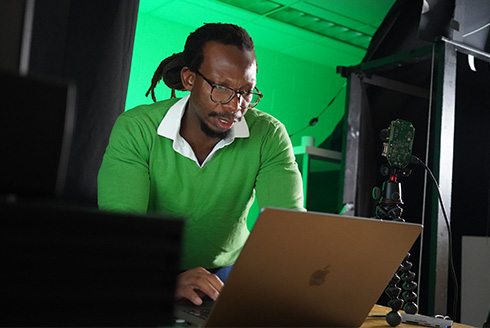
USF Researcher Expands Imaging Limits
By: Cassidy Delamarter, University Communications and Marketing
What sounds like science fiction is inching closer to reality, thanks to the work of University of South Florida Assistant Professor John Murray-Bruce.
Inside the USF Bellini College of Artificial Intelligence, Cybersecurity and Computing, the computational imaging researcher and his students are using shadows and information not easily detected by the human eye to push the limits of what machines can see and how they see it. The work at its core is theoretical, but the real-world implications are vast: From mapping terrain under dense foliage in real-time for defense operations to detecting hidden threats around corners.
“My interest in pursuing this idea of seeing around corners grew after my family was t-boned in an intersection even though we had the right of way,” Murray-Bruce said. “If we had that superhuman vision of being able to peer into the intersection, perhaps we would have been able to react accordingly to avoid that crash.”
With two major research projects underway, one funded by the Defense Advanced Research Projects Agency, the federal agency known for inventing the internet, and the other supported by a National Science Foundation’s CAREER award, Murray-Bruce is developing powerful new ways to see the world, even when it can’t be directly seen.
The five-year NSF project, which began July 1, focuses on developing a rigorous mathematical framework to improve how computational systems interpret hard-to-read or incomplete data, which could transform how images are created.
“The research has created a foundation that could support a wide range of applications we hadn’t even anticipated, including long-range X-ray imaging and national security,” Murray-Bruce said.
It’s seemingly science fiction, he added, which he says is what really piqued his interest. “Extreme types of imaging – seeing around corners, seeing deep into human tissue or biological specimen at a very fine resolution. Think a million times finer than a human hair.”
The research stems from a framework that Murray-Bruce and his students first explored through the study of shadows. What started as an effort to reconstruct 3D images of obstructed scenes from ordinary photographs of indirect light reflections evolved into an entirely new way of modeling imaging systems.
While the NSF grant focuses on the mathematical theory and its potential applications, the DARPA project is all about high-stakes testing to push X-ray imaging to extraordinary distances. A traditional X-ray system, such as those used in hospitals and airports, requires the object it is scanning to be within about 36 inches to produce an image. The challenge posed by DARPA: Build a system that works across several miles, while still producing usable images.
“We’re competing with some of the biggest names in defense technology on this project – teams from major government contractors,” Murray-Bruce said. “And yet we’re standing firm. It’s a testament to the strength of our approach and relentlessness of my talented students.”
His students play a central role in the research and experiments. For Chibuike Ezeokoli, a rising doctoral senior studying computer science and engineering, the hands-on environment in Murray-Bruce’s Information Science and Computational Imaging Lab has helped him expand his research. “I’ve had the opportunity to collaborate with and learn from other students,” Ezeokoli said. “It is the ideal environment to nurture the skills required for a future career trying to solve crucial real-world problems through research.”
Together, Murray-Bruce and his students developed novel algorithms and modeling techniques capable of interpreting data at unprecedented ranges. Their system currently achieves 97% accuracy just under one mile and 75% accuracy at nearly three miles.
“These results are promising, though we are not yet at the limit of what is theoretically possible. It’s an extreme version of shadow-based imaging,” Murray-Bruce explained. “You send X-rays through an object, and depending on what gets absorbed, you capture shadows at the detector. The problem is, the longer the distance, the weaker and noisier the shadows become.”
If selected by DARPA to continue to Phase 2 of the program, Murray-Bruce and his team will investigate scenarios with even greater distances and considerable motion blur.
https://www.usf.edu/news/2025/imaging-the-impossible-usf-researcher-pushing-boundaries-of-what-we-can-see.aspx


